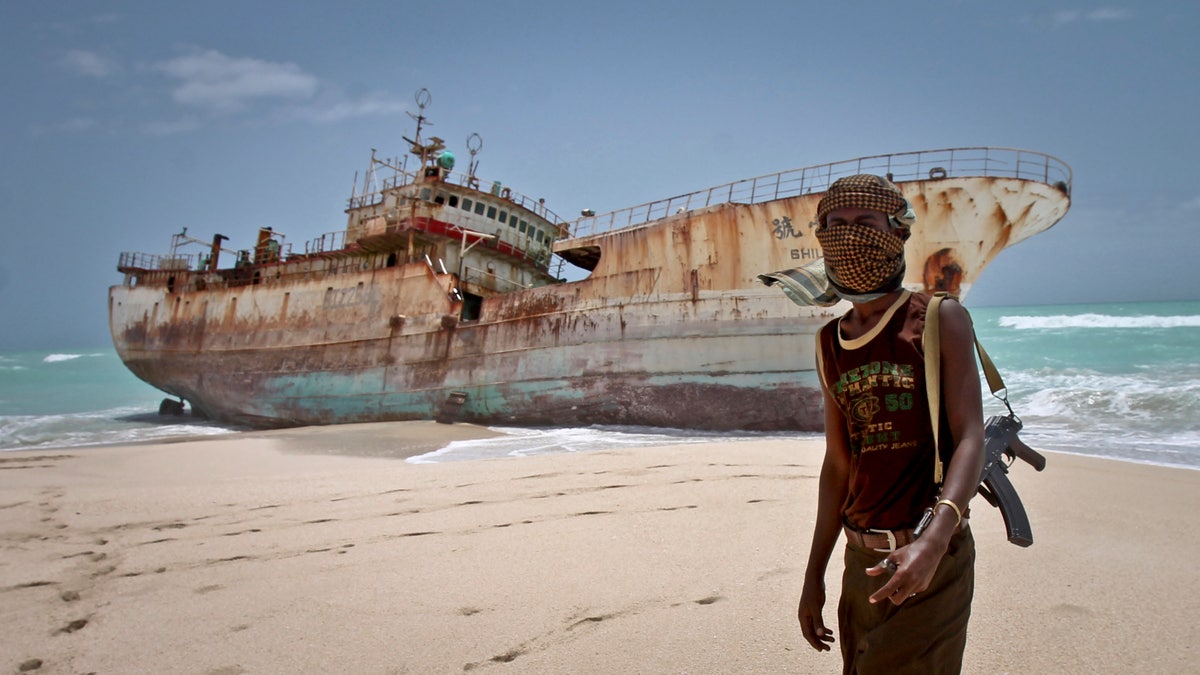
In this photo taken Sunday, Sept. 23, 2012, a masked Somali pirate stands near a Taiwanese fishing vessel that washed up on shore after the pirates were paid a ransom and released the crew, in the once-bustling pirate den of Hobyo, Somalia. Pirates have increasingly turned toward kidnapping because it yields a higher return than selling stolen goods. ((AP Photo/Farah Abdi Warsameh))
The threat of piracy and armed robbery of ships around the globe has continued to decline in the first half of 2017 - but kidnapping of crews is on the rise.
A new report from the International Chamber of Commerce (ICC) says that the first six months of the year saw a total of 87 incidents reported to the organization’s International Maritime Bureau. That compares with 97 reported for the same period in 2016.
A total of 63 vessels were boarded in maritime routes across the globe, according to the report. Twelve were fired upon and only four were successfully hijacked.
While piracy on the high seas has declined, the kidnapping of maritime crew members is on the rise.
A greater number of crews were kidnapped while at sea in 2016—the highest in the past decade—despite the fact that global piracy has seen some of its lowest levels, according to a January report from the ICC.
“The continued fall in piracy is good news, but certain shipping routes remain dangerous, and the escalation of crew kidnapping is a worrying trend in some emerging areas," said IMB Director Pottengal Mukundan in a statement released for the report.
"The kidnappings in the Sulu Sea between East Malaysia and the Philippines are a particular concern," he added.

February 11, 2009: Suspected pirates keep their hands in the air as directed by sailors aboard the guided-missile cruiser USS Vella Gulf (CG 72) (not shown), in the Gulf of Aden. (REUTERS/Jason R. Zalasky/U.S. Navy/Handout)
The January report states that there had been a threefold increase in maritime kidnappings in 2016 when compared to the previous year. Pirates kidnapped a total of 62 people in 15 separate incidents. Just over half that number were captured off the coast of West Africa. The remaining 28 were abducted from tugboats, barges, fishing vessels, and merchant ships of the coasts of Malaysia and Indonesia.
While the African coast may not be the hotbed of piracy that it once was, southeast Asia has seen a steady rise since 2015, when the region saw more than one-third of pirate attacks globally.
Most of the pirates in the region had targeted ships with commercial cargo because it could be sold on the black market. However, the crews of the large vessels are increasingly targeted for abduction because it can yield a high ransom payout. It’s widely believed that the kidnappings have increased in the region because stolen gas and other goods do not yield as high a financial reward as they once did.
According to a report from Oceans Beyond Piracy, a majority of the kidnappings occurred in the Sulu and Celebes Seas which separates the Philippines and Indonesia. The pirates will often take their captives—who are usually ranking officers and/or engineers from bulk carrier ships—to the shoreline, where they are subjected to frequent abuse and under the constant threat of being killed by their captors.
The rise in these incidents has led authorities in Indonesia, Malaysia, and the Philippines to draft a joint document on standard operating procedures in an effort to secure the waterways bordered by the countries.
In May 2016, the three countries also agreed to coordinated patrols to improve the maritime security.
